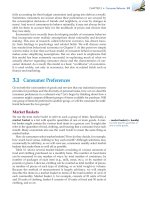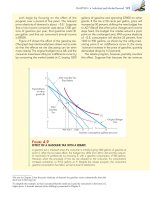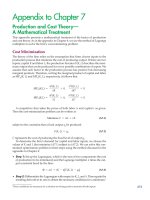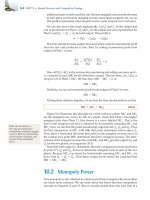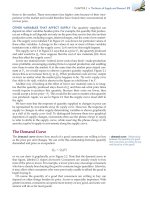(8th edition) (the pearson series in economics) robert pindyck, daniel rubinfeld microecon 133
Bạn đang xem bản rút gọn của tài liệu. Xem và tải ngay bản đầy đủ của tài liệu tại đây (92.5 KB, 1 trang )
108 PART 2 • Producers, Consumers, and Competitive Markets
8.
9.
10.
11.
12.
13.
different bundles of CDs and DVDs that he could
choose. For this part of the question, assume that he
cannot purchase fractional units.
Anne has a job that requires her to travel three out of
every four weeks. She has an annual travel budget and
can travel either by train or by plane. The airline on
which she typically flies has a frequent-traveler program that reduces the cost of her tickets according to
the number of miles she has flown in a given year.
When she reaches 25,000 miles, the airline will reduce
the price of her tickets by 25 percent for the remainder
of the year. When she reaches 50,000 miles, the airline
will reduce the price by 50 percent for the remainder of
the year. Graph Anne’s budget line, with train miles on
the vertical axis and plane miles on the horizontal axis.
Debra usually buys a soft drink when she goes to a
movie theater, where she has a choice of three sizes:
the 8-ounce drink costs $1.50, the 12-ounce drink $2.00,
and the 16-ounce drink $2.25. Describe the budget
constraint that Debra faces when deciding how many
ounces of the drink to purchase. (Assume that Debra
can costlessly dispose of any of the soft drink that she
does not want.)
Antonio buys five new college textbooks during his
first year at school at a cost of $80 each. Used books
cost only $50 each. When the bookstore announces
that there will be a 10 percent increase in the price of
new books and a 5 percent increase in the price of used
books, Antonio’s father offers him $40 extra.
a. What happens to Antonio’s budget line? Illustrate
the change with new books on the vertical axis.
b. Is Antonio worse or better off after the price change?
Explain.
Consumers in Georgia pay twice as much for avocados as they do for peaches. However, avocados and
peaches are the same price in California. If consumers
in both states maximize utility, will the marginal rate
of substitution of peaches for avocados be the same for
consumers in both states? If not, which will be higher?
Ben allocates his lunch budget between two goods,
pizza and burritos.
a. Illustrate Ben’s optimal bundle on a graph with
pizza on the horizontal axis.
b. Suppose now that pizza is taxed, causing the price
to increase by 20 percent. Illustrate Ben’s new optimal bundle.
c. Suppose instead that pizza is rationed at a quantity less than Ben’s desired quantity. Illustrate Ben’s
new optimal bundle.
Brenda wants to buy a new car and has a budget of
$25,000. She has just found a magazine that assigns
each car an index for styling and an index for gas mileage. Each index runs from 1 to 10, with 10 representing
either the most styling or the best gas mileage. While
looking at the list of cars, Brenda observes that on average, as the style index increases by one unit, the price
of the car increases by $5000. She also observes that as
the gas-mileage index rises by one unit, the price of the
car increases by $2500.
a. Illustrate the various combinations of style (S) and
gas mileage (G) that Brenda could select with her
$25,000 budget. Place gas mileage on the horizontal
axis.
b. Suppose Brenda’s preferences are such that she
always receives three times as much satisfaction
from an extra unit of styling as she does from gas
mileage. What type of car will Brenda choose?
c. Suppose that Brenda’s marginal rate of substitution (of gas mileage for styling) is equal to S/(4G).
What value of each index would she like to have in
her car?
d. Suppose that Brenda’s marginal rate of substitution (of gas mileage for styling) is equal to (3S)/G.
What value of each index would she like to have in
her car?
14. Connie has a monthly income of $200 that she allocates
between two goods: meat and potatoes.
a. Suppose meat costs $4 per pound and potatoes $2
per pound. Draw her budget constraint.
b. Suppose also that her utility function is given by
the equation U(M, P) ϭ 2M ϩ P. What combination
of meat and potatoes should she buy to maximize
her utility? (Hint: Meat and potatoes are perfect
substitutes.)
c. Connie’s supermarket has a special promotion. If
she buys 20 pounds of potatoes (at $2 per pound),
she gets the next 10 pounds for free. This offer
applies only to the first 20 pounds she buys. All
potatoes in excess of the first 20 pounds (excluding
bonus potatoes) are still $2 per pound. Draw her
budget constraint.
d. An outbreak of potato rot raises the price of potatoes to $4 per pound. The supermarket ends its
promotion. What does her budget constraint look
like now? What combination of meat and potatoes
maximizes her utility?
15. Jane receives utility from days spent traveling on vacation domestically (D) and days spent traveling on
vacation in a foreign country (F), as given by the utility
function U(D,F) ϭ 10DF. In addition, the price of a day
spent traveling domestically is $100, the price of a day
spent traveling in a foreign country is $400, and Jane’s
annual travel budget is $4000.
a. Illustrate the indifference curve associated with a
utility of 800 and the indifference curve associated
with a utility of 1200.
b. Graph Jane’s budget line on the same graph.
c. Can Jane afford any of the bundles that give her a
utility of 800? What about a utility of 1200?
*d. Find Jane’s utility-maximizing choice of days spent
traveling domestically and days spent in a foreign
country.
16. Julio receives utility from consuming food (F) and clothing (C) as given by the utility function U(F,C) ϭ FC.

